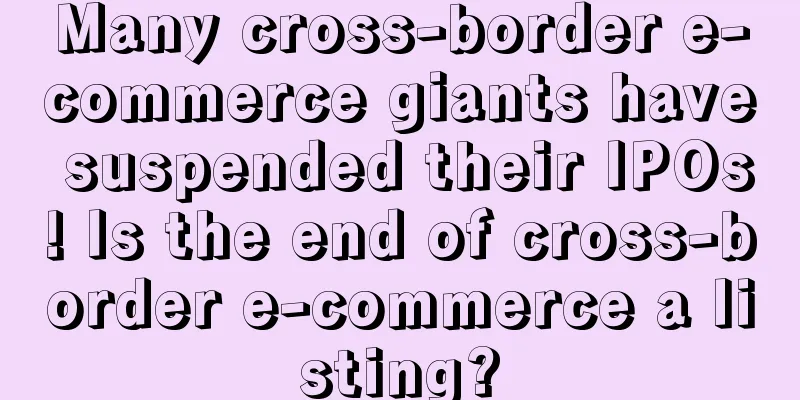Major cross-border platforms hit new highs in 2021! The cross-border e-commerce track is still booming!

|
There is now a lot of news about cross-border e-commerce on the Internet. Cross-border e-commerce can be said to be a great opportunity in the future. Many people think it is a lie when they see this. The epidemic situation abroad is so serious now that many factories doing foreign trade have closed down. Isn’t it asking for trouble to do cross-border e-commerce now? Actually, it is not. As an emerging trade format, cross-border e-commerce has also become one of the main forces for stable growth in foreign trade in recent years. Affected by the epidemic, the global online purchase rate has risen sharply. Compared with the first quarter of 2019 (before the epidemic), cross-border trade in the first quarter of 2021 increased by nearly 300% year-on-year. At the end of April, various cross-border e-commerce platforms released their first quarter financial reports, and as expected, all showed an increase. Amazon: Revenue exceeds $108.52 billion, setting a new record On April 29, Amazon released its first quarter 2021 financial report, which showed that Amazon's revenue in the first quarter reached US$108.52 billion, a year-on-year increase of 44%; net profit was US$8.107 billion, a year-on-year increase of 219.8%, far exceeding analysts' expectations. Among them, Amazon's online store had the highest revenue in the quarter, with revenue of US$52.901 billion, nearly half of the total revenue, accounting for 48.7%. In addition, Amazon's fastest growing business in the quarter was third-party seller services, with a year-on-year growth of more than 60%. Amazon said its strong sales performance in the first quarter will continue in the second quarter. The company expects sales from April to June to reach between $110 billion and $116 billion, which would mark Amazon's third consecutive quarter of revenue exceeding $100 billion. Shopify: Revenue of US$989 million, revenue and GMV both increased by more than 100% year-on-year On April 28, Shopify, a global e-commerce SaaS service provider, released its first quarter 2021 financial report. The report shows that in this quarter, Shopify's revenue was US$989 million, a year-on-year increase of 110%; gross profit was US$558.7 million, a year-on-year increase of 117% (adjusted gross profit was US$565.1 million, a year-on-year increase of 114%); net profit was US$1.258 billion (including the company's US$1.3 billion unrealized gain on its equity investment in Affirm), while the net loss in the same period last year was US$31.4 million. It is reported that among the $989 million in revenue, Shopify's subscription solution revenue was $320.7 million, a year-on-year increase of 71%; business solution revenue was $668 million, a year-on-year increase of 137%. In this quarter, Shopify's global merchants' total merchandise volume (GMV) was $37.3 billion, a year-on-year increase of 114%; total transaction payment volume (GPV) was $17.3 billion, accounting for 46% of the GMV this quarter, while it was $7.3 billion in the same period last year, accounting for 42%. eBay: Revenue of $3 billion, the highest growth since 2005 On April 29, eBay announced its first quarter financial results ending March 31, 2021. The financial report shows that eBay's revenue in the first quarter reached US$3 billion, a year-on-year increase of 42%, and a year-on-year increase of 38% excluding the impact of exchange rate changes. The total transaction volume (GMV) was US$27.5 billion, a year-on-year increase of 29%, and a year-on-year increase of 24% excluding the impact of exchange rate changes. In the first quarter, eBay continued to scale managed payments globally, with more than 52% of transactions on the global platform processed through managed payments. At the end of the first quarter, eBay had more than 4 million global sellers migrated to managed payments, and more than 80% of US sellers had completed the migration. The introduction of managed payments has simplified the checkout process for eBay, and data shows that unpaid items in fixed-price transactions decreased by about 80% in the first quarter. At the same time, eBay's paid promotion service (Promoted Listings) achieved revenue of nearly $224 million, a year-on-year increase of 64%, and a year-on-year increase of 58% excluding the impact of exchange rate changes. Facebook: Revenue of $26.17 billion, up 48% year-on-year On April 29, Facebook released its first quarter financial report for fiscal year 2021 ending March 31. The report showed that Facebook's total revenue in the first quarter was US$26.171 billion, a 48% increase from US$17.737 billion in the same period last year; net profit was US$9.497 billion, a 94% increase from US$4.902 billion in the same period last year; diluted earnings per share was US$3.3 . As of March 31, 2021, Facebook had 2.85 billion monthly active users, a year-on-year increase of 10%. Judging from the financial report results alone, Facebook's performance is quite good, showing the strong recovery of the advertising industry as the economy recovers. In general, foreign countries are now severely affected by the epidemic, and a large number of physical stores have closed down. It is difficult to sell large quantities of goods imported from China offline, and it is inevitable that foreign trade factories will be hindered. However, cross-border e-commerce and foreign trade factories are completely different. Cross-border e-commerce is mainly a toc model, directly facing consumers , starting with light asset operations, with lower thresholds, fewer sellers and more buyers, and basically no deposit, only monthly rent, which can save a lot of costs. Under the influence of the epidemic, many residents chose to stay at home, and the penetration of cross-border e-commerce in the European, American and Southeast Asian markets has not decreased but increased. In other words, in an environment like the epidemic, it has not only not affected the development of cross-border e-commerce, but also promoted cross-border e-commerce's share of foreign markets. Both imports and exports have shown a relatively large growth trend. In recent years, the Chinese government has further encouraged the development of cross-border e-commerce by proposing free trade zones and the "Belt and Road" initiative. The country has continuously increased its support for cross-border e-commerce and has introduced policies such as adding cross-border e-commerce comprehensive pilot zones and exempting some export goods from taxes and fees. As you can imagine, under the heavy blow of the 2020 epidemic, the data of e-commerce operations has not only not been greatly impacted, but has even shown signs of rising continuously. For example, Amazon's North American warehouses are almost full. The popularity of cross-border e-commerce platforms in Southeast Asia such as Shopee and Lazada is also growing rapidly. Judging from last year's market conditions, this year will be a year of rebirth. |
<<: How can a beginner do cross-border e-commerce? Eight core points will help you win the market!
Recommend
What is bridenew? bridenew review
Boy London is a British streetwear brand founded b...
What is Amazon Neptune? Amazon Neptune Review
Amazon Neptune is a fast , reliable, and fully man...
What is Yixingtong? Yixingtong Review
Shenzhen Yixingtong Supply Chain Management Co., L...
In foreign trade business communications, if you encounter these situations, don’t just send emails, give the customer a call!
In the foreign trade industry, developing custome...
The most difficult year in history! The price of the second-instance license exceeds 10,000 yuan, and the seller is blocked as soon as he buys it...
2020 can be said to be the most difficult year to ...
Sky-high freight rates of $10,000 are coming! Shipping companies: Price increases, warehouse overflows, and container shortages are unresolved!
This year, under the severe impact of the epidemi...
What is Amazon Reserve? Review of Amazon Reserve
Amazon Reserve Amount refers to the amount that Am...
Amazon out-of-stock response plan and remedies
How to deal with Amazon out of stock and how to r...
What is Vine Voice? Vine Voice Review
In October 2016, Amazon released new rules for rev...
The success rate of new products on the list is nearly 100%? New sellers in the Red Sea quickly sprinted to the top of the new product list in a short period of time, and many categories of products remained at the top of the list within half a year.
Anonymous user My C position New sellers in the no...
Where can I see Amazon’s natural traffic?
Amazon merchants should pay attention to the store...
An experienced operator with many years of experience in cross-border business will teach you how to effectively analyze Amazon advertising
text As an "old operator" who has been ...
How to handle Amazon returns with minimal losses?
Returns, the nightmare of Amazon sellers. In addi...
Policy tightening! Poland VAT planning as soon as possible! Funds freezing and store association measures will be taken!
On August 19, the Polish State Tax Administration ...
The closure of the store was a mistake? Amazon confirmed
Since the outbreak of the epidemic, not only have ...









